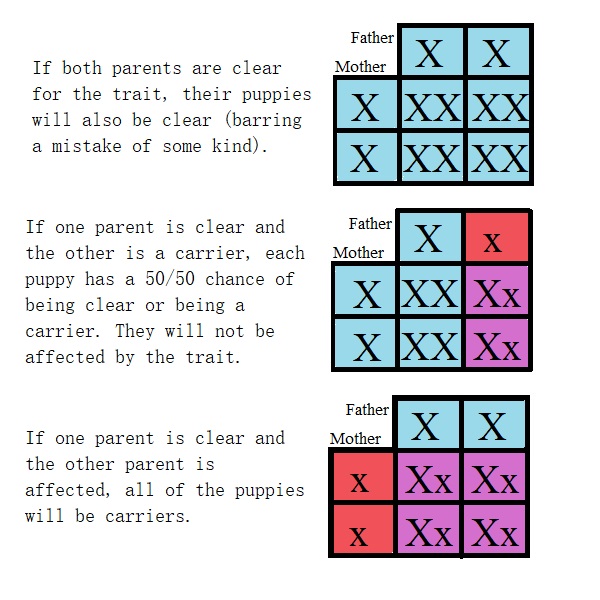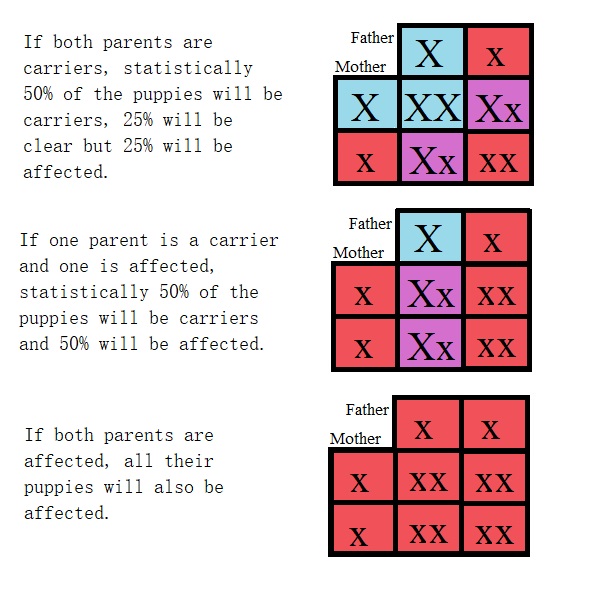Posts Tagged: genetic testing
Centronuclear Myopathy (CNM) is an inherited congenital disorder that causes muscle dysfunction.
ABOUT CNM
In a nutshell, CNM in Labradors causes muscle wasting which makes moving normally difficult. Some dogs have severe symptoms while other dogs are only mildly affected.
In the past, it’s been called generalized muscle weakness, polyneuropathy, muscular myopathy, muscular dystrophy, hereditary myopathy.
Breeds affected are Labrador Retrievers, plus doodles and other Lab mixes.
Here is a video of a Labrador suffering from acute CNM.
To develop a genetic test, researchers collected samples from 7,426 Labradors living in 18 countries. They found 80 dogs from various countries had two copies of the mutated gene. These dogs all showed muscle wasting symptoms. Of the 1,172 dogs that had one copy of the mutated gene, none showed symptoms which showed that CNM in Labradors is caused by a simple recessive gene.
Dogs with two normal genes are normal. Dogs with one normal gene appear normal, but could pass the mutated gene to their puppies. Dogs with two mutated gene are affected and will develop muscle wasting.
Currently researchers believe the mutated gene is the result of a single mutation. Also that the gene spread rapidly through the Labrador population because many people bred to a small group of popular sires about 60 years ago.
CNM also affects people. Locating the mutated gene in Labradors is helping scientists study the disorder in people.
SYMPTOMS
Symptoms generally develop between two to five months of age and include gait abnormalities, generalized weakness, tiring easily and muscle wasting. CNM can affect both sexes and all three recognized colors.
Puppies seem normal at first, but as they grow they develop generalized muscle weakness and abnormal postures. Another sign is an odd “bunny hop” with the rear legs. Often they can’t exercise much and may collapse in colder weather.
Here is a video of another Lab having a particularly tough day although she’s determined to get her bumper.
Affected dogs will never develop normal muscles. You can see the difference most clearly in the chest and rear legs.
There is no cure. However some dogs, with their owner’s help, have learned how to overcome most symptoms. This dog is doing quite well.
According to his owners, “As a puppy, he couldn’t hold his head up, control his tongue, hold a tug toy, walk for more than a few feet without having to crawl, or climb stairs.”
PREVENTING CNM IN LABRADORS
CNM is caused by a recessive gene which means a dog can have one copy of the gene and appear normal. If that dog is bred to another dog that appears normal, but has the same recessive gene, some of the puppies may be affected with CNM.
CNM affected dogs should not be bred as all of their puppies will carry the gene. Because of the muscle dysfunction, it may be difficult for a male to breed naturally and even harder for a female to carry and whelp puppies.
Genetic testing is the best way to prevent producing a dog with CNM. Many laboratories offer the testing, but my favorite is DDC. They are available to answer questions, can help order the correct tests and are reasonably priced. They can also provide the swabs needed to collect DNA.
To collect your dog’s DNA, make sure he hasn’t eaten or had anything to drink for at least an hour. You may need to put a leash on your dog and/or have a helper handy to keep him still. The collection doesn’t hurt, but some dogs may object anyway.
Wash your hands and pull out one swab at a time. Lift your dog’s lip on the side of his muzzle and insert the swab between his lip and gums. Swirl several times and remove. Place the swab back in the plastic wrap. Repeat on the other side of his muzzle and then a third time on one side or the other.
Write your name, your dog’s name, breed and registration number on an envelope and place the swabs inside. Seal and place the envelope inside another envelope, seal, address and mail.
If you are collecting samples from more than one dog, be sure to keep their swabs separate and wash your hands between collections.
And, no, CNM is not the same as Exercise Induced Collapse (EIC), although both disorders are genetic. CNM is a muscle weakness whereas EIC is a neurologic dysfunction.
(Originally posted October 25, 2012 – Updated November 18, 2022)

Genetic basics
Luckily Gregor Mendel tested his theories on the garden pea that has a relatively simple genetic structure.
He crossed yellow peas with green peas and tall plants with short plants to discover the fundamental laws of inheritance.
When he crossed yellow peas with green peas he often got only yellow peas.
But when he crossed the second generation together he got a few green peas mixed in with three times as many yellow peas. When he crossed green peas together, he got only green peas.
Mendel theorized that each parent contributed the “elementen” (one gene) for any given trait so the offspring had a pairing of those two genes.
But what you see on the outside doesn’t always tell you what’s on the inside – the genetic makeup.
In today’s terms, we would say the gene for yellow is dominant over the gene for green which is recessive.
When he crossed yellow with yellow and got only yellow, at least one of the parent plants was homozygous for yellow – meaning that parent plant carried only the yellow gene.
But when he crossed yellow to yellow and got some green peas, *both* of the parent plants carried the recessive green gene.
When he crossed green to green he could not get yellow because *neither* parent plant carried the yellow gene.
Genetic testing
Before breeding, the DNA strands carrying “… chromosome pairs are split apart and distributed into cells called gametes. Each gamete contains a single copy of every chromosome, and each chromosome contains one allele for every gene.”
Which variation of a gene winds up on which DNA strand and which strand from the father combines with which strand from the mother is due to chance which makes breeding so very interesting.
Genetic testing helps to make breeding decisions a little easier. Many genetic tests for our dogs are for a simple recessive gene, like yellow or green in the garden pea.
What this means is that there is one gene controlling the trait with two or more possible variations (“alleles”) – a dominant allele and recessive alleles.
The recessive allele will only express itself if both parents contributed recessive alleles. When there is only one recessive allele the dominant allele it will ‘cover up’ the recessive.
Terminology – English.OxfordDictionaries.com
– allele – one of two or more alternative forms of a gene that arise by mutation and are found at the same place on a chromosome
– dominant – relating to or denoting heritable characteristics which are controlled by genes that are expressed in offspring even when inherited from only one parent
– gene – a unit of heredity which is transferred from a parent to offspring and is held to determine some characteristic of the offspring
– heterozygous – having two different alleles of a particular gene or genes
– homozygous – having two identical alleles of a particular gene or genes
– recessive – relating to or denoting heritable characteristics controlled by genes that are expressed in offspring only when inherited from both parents, i.e., when not masked by a dominant characteristic inherited from one parent
Using genetic testing
If your puppy’s parents have been tested or if your puppy shows a genetic trait, such as yellow or chocolate color, you can make an educated guess about his genetic make up.
If he is yellow, then his parents are either yellow or carry yellow as a hidden gene. Both must carry at least one copy of the yellow gene.
If he is black, but has a yellow parent, then he carries one copy of the gene for yellow. It works the same for chocolate.
Yellow and chocolate are controlled by different genes so you can’t know if he carries the gene for the other color based on his color.
With one exception. Yellow Labradors usually have black noses and eye rims. When a yellow Lab has a chocolate nose and eye rims, he is homozygous for both chocolate and for yellow. Although it is a natural color in the breed, it is a disqualification in the show ring.
In a graph, the dominant trait (like black in Labradors) is capitalized and the recessive trait (chocolate) is lower-case:
BB = homozygous black in capital letters
Bb = heterozygous black in capital letters (hidden chocolate in lower case)
bb = homozygous chocolate in lower case
A yellow puppy with chocolate points, is shown as bbee with “e” meaning yellow. The dominant trait – “E” – means “not yellow.”
Early in the Labrador’s history, yellow and chocolate puppies would appear occasionally. Because those colors were not popular, they were rarely bred (and sometimes not even allowed to live).
With no genetic testing available and limited knowledge of inheritance, breeders didn’t know that those recessive colors hid in their dogs’ genetics.
The recessive color could appear if the dog was bred to another dog who carried the same recessive color.
It is possible for a recessive gene to remain hidden for many generations. For example, Sandylands Mark, born in 1965, was black carrying chocolate despite 19 generations of blacks and yellows in his pedigree.
As a side note, because chocolate is a recessive gene saying a dog is “dominant chocolate” is incorrect. Chocolate is recessive to black and is a separate gene from yellow. So I think they mean “pure for chocolate” instead.
For traits you can’t see, you should test the puppy unless both parents are clear for the trait.
EIC, CNM and PRA are also examples of simple recessives.
Here are some charts showing potential outcomes for a hypothetical trait where “X” is the dominant allele and “x” is the recessive allele.


These examples hold true for any trait that is a simple recessive.
Note: statistics only hold true with very large samples, except for breeding clear to clear or affected to affected where all puppies will be like their parents. However a carrier to carrier breeding could have all clear puppies or could have all affected puppies.

I read an interesting article this morning. Are breeders blind? Or are we operating under a misconception? The article concludes that the majority of dogs are not normal.
WHAAAT?
“According to Padgett (1991), most breeders continue to believe that the dogs they own are genetically normal.”
Well, gee, I thought they were.
Padgett also reported that “the average number of defects in most breeds may be fourteen.” Some breeds could have as many as 58 defects.
Well, not MY breed.
When the Exercise Induced Collapse (EIC) test came out, I tested my Labs and was blindsided to learn that one was a carrier.
OMG! My dog is defective! I had no idea that one of my dogs harbored that dreaded disease.
My reaction seems to be typical of many breeders. Not only do we believe most dogs are genetically normal, but that having a dog with a defective gene was so out of the ordinary that it should be kept a secret. If we talk about having a defective gene some people might feel our dogs are “less than average or perhaps abnormal.” So we bury our heads in the sand and hope that it will go away.
If we can change our way of thinking – that most dogs are not genetically normal – then it won’t come as such a surprise to get results showing defective genes. If it’s not such a surprise, then maybe we’ll be more willing to share the results thus making it easier to eradicate that gene.
My dog carries one copy of the EIC gene. Dogs with two copies of the gene may collapse under some circumstances. She was fine, but I had to be careful to only breed her to a male who was clear of the gene.
Whew! That doesn’t sound so bad.
So we test before deciding to breed and choose mates wisely.
To learn more, see:
Breed dilemmas and extinction by Dr. Carmen L. Battaglia in The Labrador Quarterly, Winter 2010-11, discussing Padgett, George, “Genetics I Introduction,” 1991 Beagle Review, Darcroft Publishing, Wilmington, VT, Vol. 1, No. 1, Winter 1991, pg. 14-16.


